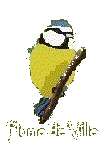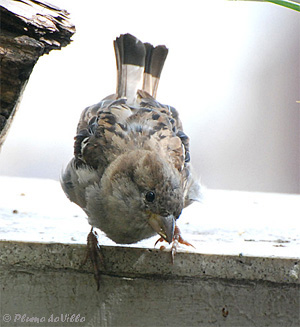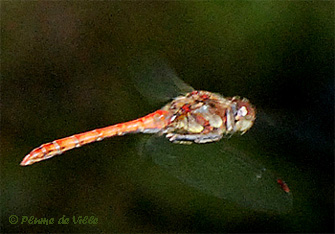Plume de Ville
From day to day.
°°°°°°°°°°°°°°°°°°°°°°° °
September 2008
September 1st
An eccentric this young
house sparrow, with bicolour tail feathers.
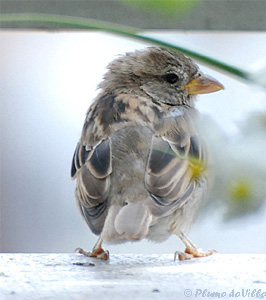
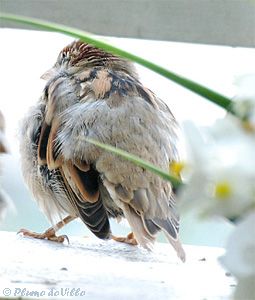
Pink delicacy in the
plumage of this other youngster.
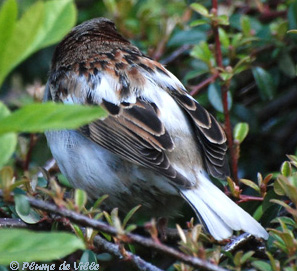
You can
find sparrows whose feathers are white, some feathers (as this one) and
sometimes all of them. As the first ones to visit our balcony, whose
right wing
had white pinions. These are cases of partial albinism or leucism
fairly
prevalent among sparrows, which are of genetic or alimentary origin.
The white-tailed sparrows are not uncommon, but this is the first time
I see a
youngster with bicolour rectrices. The other young sparrows that were
present
with him had very clear hues.
3 September
The visit of the Crane Fly.
One of
these big "mosquitos" clumsy on his big legs, who was flying on the
balcony, entered, as often happens in the house.
You see often which are quite dull beige brown. It must be said that by
far
they all seem to be greyish.
But on the photo this one appeared surprisingly beautifully coloured,
with
iridescent wings and a striped body.
It is a Crane Fly or Daddy long legs (Tipulidae), I think it is of the
genus
Nephrotoma, a male.
His legs are so long that I did not see that one of its legs reached
out of the
frame!
Nearer here.
It
belongs
to the order of diptera.
The
opportunity to see its halteres which replace the second pair of wings,
clearly
visible here.
And
his
head, strange, with long antennae.
No, it does not sting!
This insect looks like a very big "mosquito" but it is harmless with
his long legs so fragile. They break easily but do not sprout again. To
handle
with care.
Its larvae, worms, dig tunnels and attack the roots.
It
is also known as mosquito hawk,
mosquito eater (or skeeter eater), gallinipper,
gollywhopper, and jimmy
spinner..
Another
crane fly, dull beige-toned, which attends the prairies and is of the
genera kind Tipulidae.
More about Tipulidae:
- http://aramel.free.fr/INSECTES15'-2.shtml
- http://papylou.lalibreblogs.be/archive/2008/06/index.html
- http://www.insectes-net.fr/tipule/tipul2.html
- http://fr.wikipedia.org/wiki/Tipulidae
- http://www.galerie-insecte.org/galerie/wiki.php?Nephrotoma
- http://www.uky.edu/Ag/CritterFiles/casefile/insects/flies/craneflies/craneflies.htm
5 September
For
several
days starlings pass in bands in the late afternoon.
The noisy gang settles for a few moments on the terraces. It quickly
swallows
the few seeds that can be found, then at a mysterious signal some
starlings fly
and the whole group follows.
We see them very early this year.
With the overcast sky of these days, already a small sign of fall?
Yesterday
a
common kestrel pursued sparrows who took refuge on the balcony in the
protection
of dense branches of our fir. The kestrel tried to follow them with a
big noise
of wings and leaves and leaves. I saw him fly away vertically.
Beautiful
silhouette, tail fanned... empty-clawed. Three minutes later, two then
three
sparrows came out of their hiding place.
12 September
Among
neighbors...
On the branch
overhanging above the tiny waterway in the calm waters of the Bois de
Vincennes, a green Lestes and red Sympetrum are settled.
The little green Lestes defends bitterly its small territory. As soon
as a congener
dare point the tip of a wing, it darts and pursues the intruder (or
tries to make
friends somewhat brutally?) before returning to his post at exactly the
same
place.
The Sympetrum rests in the sun, posed a bit further, wings folded
forward.
It is not indifferent to the Lestes. Each time that the Lestes walks
out a rival,
it does not forget to bother the Sympetrum.
And if no other Leste is in the corner, he flies periodically see
closely, and
even very closely the red individual at the extremity of the branch.
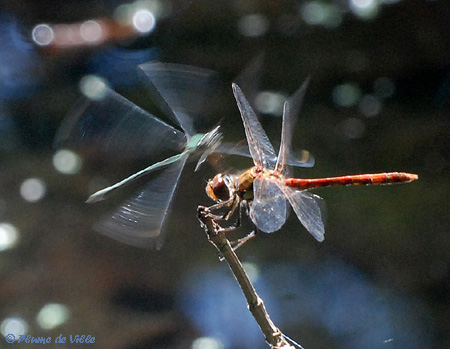
The
placid Sympetrum,
hesitates long-time before moving under the insistence of the Lestes,
it places
its wings horizontally and flies.
Delighted, the Lestes immediately resumed his place on the branch.
After
a few
seconds hovering under the branch, above water, the Sympetrum
stubbornly,
regains its place, also exactly at the same location.
It places its wings horizontally.
And
a short
time later, suddenly as a closing umbrella, it folds up its wings
forward.
It is ready for the arrival of the next Lestes!
What does not fail to occur about twenty seconds later and there we go
...
Once, twice, thrice...
We almost heard our Sympetrum sigh!
I do not know how long did the game last as we left both players at
their game.
With yellow
stripes on the chest, legs net yellow, the all red neighbour is a Common Darter (I
think
the two small black spots on the last segments of the abdomen are
almost inexistent
in this individual).
[Anisoptera.
Libellulidae. Sympetrum
striolatum.]
It is a dragonfly;
its wings are brought to the horizontal or, as here, forward, never
backward.
This is a male, it the male witch is red-orange, its lady is in yellow.
Size:
3.5-4.5 cm.
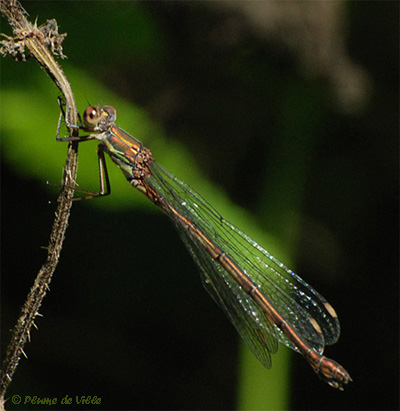
Green it is the girl,
the "green Lestes."
[Zigoptera. Lestidae. Lestes
viridis.]
Brilliant
metallic green, it takes coppery reflections with age as this beautiful
female.
The characteristic little point on the chest here is not green but
coppery.
At this time of year, he lay under the bark of trees overhanging the
water. At
the outbreak in spring, the larvae will fall into the water.
One can see many individuals at this time. There were everywhere around
rivers,
the brambles or clinging to the branches of trees.
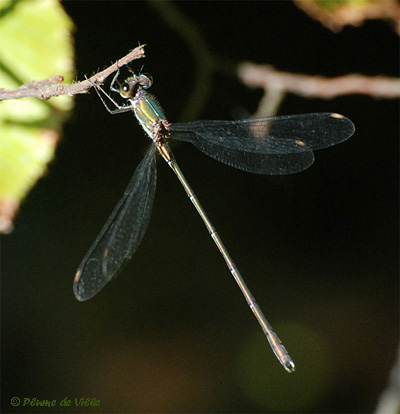
Here is the
male; he just kept the green of its dress.
Anal white appendices are clearly visible. The wings are open as it use
to be when
at rest for the lestes.
Size: 4-5 cm
18 September
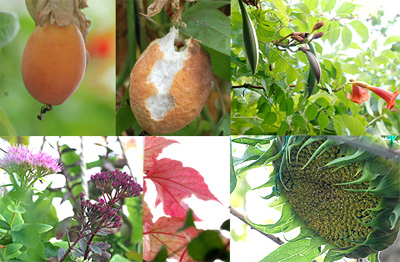 Cool weather
these days, with 10°C in the morning, and a small cold wind
from east.
Cool weather
these days, with 10°C in the morning, and a small cold wind
from east.
I took indoors almost all orchids that spent the summer on the balcony,
it's
too cold at night for them now.
The fruit of the passionflower have takers and were devoured. By whom?
A big suspicion
points to gastropods.
The bignonias present its lasts flowers and its fruit in large pods.
The sedums are in bloom and vines are already red. The sunflower
continues its
maturation but it is still far from providing bird seed for the winter!
Dame great
tit approaches the balcony, superb in his brand new dress. A success
this black
lavaliere over the delicately yellow waistcoat.
23 September
And
cool
autumn morning (8°C).
The turn of two blue tits come to be admired.
The starlings in early September remained just over a week; we do not
see them
anymore now.
Return of greenfinches came to watering.
Chilly
Friday
morning at Parc Floral, offset by a small festival of songs and flights
under a
beautiful blue sky.
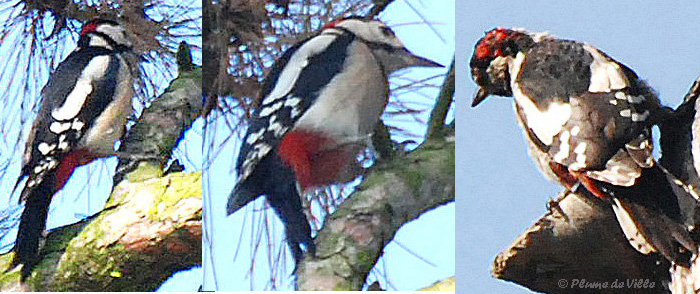
Flying
from
a pine tree to another in a rustle of wings and "kik, kik", in black
and white dresses red spotted at the abdomen and head:
The Great Spotted Woodpecker [Dendrocopos major. Picidés.]
One of the most common woodpeckers.
It is quite fearful. Three youths and an adult (perhaps two) moving up
into the
pines, remain seldom motionless, turning around the trunks far from
these bipeds
that 20-30 meters (!) below tried to follow them discreetly.
Here at left, a juvenile which still has a little of his red cap on top
of the
head.
The male
has a black head and a dark red spot in the nape visible from afar. The
female
is similar but with the black nape. The young, curiously, has a red
cap.
Young, almost adults, accompanying adults that day, are losing their
red feathers
at the top of the head, giving them a funny bad hair dressed appearance.
The
red
feathers of their belly (sub-caudal) is clearer and more orange than
among
adults (shown above on the first 2 photos) where they are dark red.
The strong tail serves as a solid stand.
Outside the nesting period, the Great Spotted Woodpecker is a loner,
but these youngsters
were still following the adults.
In flight, the most visible characteristics are the large white oval
tasks in
the shoulders and white bars of its wings.
Under the
eyes of many familiar European Robin [Erithacus rubecula] a few floors
below.
Around the
trunk, an Eurasian Nuthatch
[Sitta
europaea] turns in spiral.
And at ground level,
Chaffinches [Fringilla coelebs] explore the bushes.
29 September
The
calm reigns
on the small pond, a couple of Ruddy
Shelduck [Tadorna ferruginea] is quiet on the bank until
the arrival of
a flight of noisily Goose, a half-dozen Canada Goose [Branta
canadensis] and a
Branta [Branta leucopsis]. The reaction of shelduck is unexpected and
is
rather... strong.
the barnacles!
I think monsieur
is at the top and it is madame which honks his anger. In this season,
the male don't
have anymore its distinctive and easily recognizable black collar; but
the head
of the female is whiter than his.
Outstretched
neck at water level, the legs propeller at the rear at maximum speed,
the
beautiful cinnamon torpedo is launched.
What the heck is this?
I'm going to show you.
There we go!
(And it's going fast, very fast!)
And boom!
Go out.
Admit that I
the technical
skill. Isn't?
In the
background,
a Canada goose, but the target rushed so strongly, is the Barnacle
Goose.
Oops! Ouch!
Yeah! You have to know how to get out of the way on time; sometimes
it's just a
little late.
(Where you going?)
In any case,
it works.
Shelduck 1,
Branta 0.
Come on, next
one.
Even
if,
when a Canada goose is on its way, the upset sheldrake charges also it,
it is
the barnacle that is its choice target, the object of his wrath. What
has the barnacle
do to the sheldrake? Big personal quarrel? Because the anger of the
shelduck is
great.
The barnacle will set again on the water, but the lady shelduck not
calmed by
his early success, indefatigable, always followed by his male, will
charge
again and again.
The hunt will last long. Until, tired, the barnacles other branta climb
back on
the bank below. At least... for a time.
